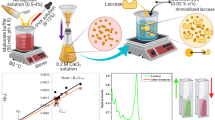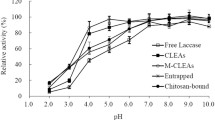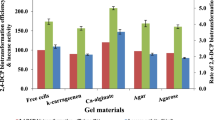Abstract
Combinatorial application of different dye removal methods with specific features can lead to a novel and robust decolorizing system. In this study the bacterial spore laccase and TiO2 nanoparticles were co-entrapped to enhance dye degradation. The optimum entrapment conditions were achieved in the presence of alginate 2% (w/v) and Ca2+ (0.2M), Cu2+ (0.05M) and Zn2+ (0.25M) as matric polymer and counterions, respectively. Immobilized laccase showed a wide range of pH and temperature stability in comparison to the free spores. The entrapped degradation systems include single laccase, single TiO2, laccase + TiO2 (one-step remediation), TiO2/laccase (two-step remediation), and laccase/TiO2 (two-step remediation) that result to the 22%, 26% 45.6%, 47.6%, and 69.3% indigo carmine decolorization in 60 min. In the kinetic studies, the half-life of indigo carmine (25 mg/l) in the remediation processes containing laccase, TiO2, laccase + TiO2, TiO2/laccase, and laccase/TiO2 was calculated as 173, 138, 161, 115, and 57 min, respectively. The degradation products by co-entrapped system were not toxic against Sorghum vulgare. The results showed two-step decolorization by co-entrapped spore laccase and TiO2 nanoparticles, including the pretreatment of dye by laccase, and then, treatment by TiO2 has potential for degradation of indigo carmine.







Similar content being viewed by others
References
Antecka K, Zdarta J, Siwińska-Stefańska K, Sztuk G, Jankowska E, Oleskowicz-Popiel P, Jesionowski T (2018) Synergistic degradation of dye wastewaters using binary or ternary oxide systems with immobilized laccase. Catalysts 8:402
Asgher M, Wahab A, Bilal M, Iqbal HMN (2018) Delignification of lignocellulose biomasses by alginate–chitosan immobilized laccase produced from Trametes versicolor IBL-04. Waste Biomass Valor 9:2071–2079
Barreca S, Colmenares JJV, Pace A, Orecchio S, Pulgarin C (2014) Neutral solar photo-fenton degradation of 4-nitrophenol on iron-enriched hybrid montmorillonite-alginate beads (Fe-MABs). J Photochem Photobiol A Chem 282:33–40
Barreca S, Colmenares JJV, Pace A, Orecchio S, Pulgarin C (2015) Escherichia coli inactivation by neutral solar heterogeneous photo-Fenton (HPF) over hybrid iron/montmorillonite/alginate beads. Int J Struct Civil Eng Res 3:317–324
Bhatia D, Sharma NR, Singh J, Kanwar RS (2017) Biological methods for textile dye removal from wastewater: a review. Crit Rev Environ Sci Technol 19:1836–1876
Chauhan PS, Goradia B, Saxena A (2017) Bacterial laccase: recent update on production and industrial applications. 3Biotech 7:323
Cheng Y, Lin H, Chen Z, Megharaj M, Naidu R (2012) Biodegradation of crystal violet using Burkholderia vietnamiensis C09V immobilized on PVA-sodium alginate-kaolin gel beads. Ecotoxicol Environ Saf 83:108–114
Daâssi D, Rodriguez-Couto S, Nasri M, Mechichi T (2014) Biodegradation of textile dyes by immobilized laccase from Coriolopsis gallica into Ca-alginate beads. Int Biodeterior Biodegradation 90:71–78
Faccio G (2018) From protein features to sensing surfaces. Sensors (Basel) 18:1204
Floriano L, Ribeiro LC, Saibt N, Bandeira NMG, Prestes OD, Renato Z (2018) Determination of six synthetic dyes in sports drinks by dispersive solid-phase extraction and HPLC-UV-Vis. J Braz Chem Soc 29:602–608
Jaiswal S, Gomashe AV, Agrawal S (2014) Decolorization potential of Bacillus sp. for removal of synthetic textile dyes. Int J Curr Microbiol App Sci 3:83–88
Kamwilaisak K, Wright PC (2012) Investigating laccase and titanium dioxide for lignin degradation. Energy Fuel 26:2400–2406
Lade HS, Waghmode TR, Kadam AA, Govindwar SP (2012) Enhanced biodegradation and detoxification of disperse azo dye Rubine GFL and textile industry effluent by defined fungal-bacterial consortium. Int Biodeterior Biodegrad. 72:94–107
Lee KY, Mooney DJ (2012) Alginate: properties and biomedical applications. Prog Polym Sci 37:106–126
Lee BB, Ravindra P, Chan ES (2013) Size and shape of calcium alginate beads produced by extrusion dripping. Chem Eng Technol 36:1627–1642
Lellis B, Favaro-Polonio CZ, Pamphile JA, Polonio JC (2019) Effects of textiles dyes on health and the environment and bioremediation potential of living organisms. Biotechnol Res Innov 3:275–290
Li P, Zhao G, Zhao K, Gao J, Wu T (2012) An efficient and energy saving approach to photocatalytic degradation of opaque high-chroma methylene blue wastewater by electrocatalytic pre-oxidation. Dyes Pigments 92:923–928
Li HX, Xu B, Tang L, Zhang JH, Mao ZG (2015) Reductive decolorization of indigo carmine dye with Bacillus sp MZS10. Int Biodeterior Biodegradation 103:30–37
Lu L, Zhao M, Wang TN, Zhao LY, Du MH, Li TL, Li DB (2012a) Characterization and dye decolorization ability of an alkaline resistant and organic solvents tolerant laccase from Bacillus licheniformis LS04. Bioresour Technol 115:35–40
Lu L, Zhao M, Li GF, Li J, Wang TN, Li DB, Xu TF (2012b) Decolorization of synthetic dyes by immobilized spore from Bacillus amylolique-faciens. Catal Commun 26:58–62
Majeau JA, Brar SK, Tyagi RD (2010) Laccases for removal of recalcitrant and emerging pollutants. Bioresour Technol 7:2331–2350
Monteiro SM, Clemente JJ, Henriques AO, Gomes RJ, Carrondo MJ, Cunha AE (2005) A procedure for high-yield spore production by Bacillus subtilis. Biotechnol Prog 4:1026–1031
Nakata K, Fujishima A (2012) TiO2 photocatalysis: design and applications. J Photochem Photobiol C 13:169–189
Pabst B, Pitts B, Lauchnor E, Stewart PS (2016) Gel-entrapped Staphylococcus aureus bacteria as models of biofilm infection exhibit growth in dense aggregates, oxygen limitation, antibiotic tolerance, and heterogeneous gene expression. Antimicrob Agents Chemother 60:6294–6301
Patel Y, Gupte A (2015) Biological treatment of textile dyes by agar-agar immobilized consortium in a packed bed reactor. Water Environ Res 3:242–251
Ping W, Xuerong F, Li C, Qiang W, Aihui Z (2008) Decolorization of reactive dyes by laccase immobilized in alginate/gelatin blent with PEG. J Environ Sci 20:1519–1522
Singh K, Arora S (2011) Removal of synthetic textile dyes from wastewaters: a critical review on present treatment technologies. Crit Rev Environ Sci Technol 41:807–878
Skocaj M, Filipic M, Petkovic J, Novak S (2011) Titanium dioxide in our everyday life; is it safe? Radiol Oncol 45:227–247
Smidsrød O, Skjak-Braek G (1990) Alginate as immobilization matrix for cells. Trends Biotechnol 8:71–78
Strong PJ, Claus H (2011) Laccase: a review of its past and its future in bioremediation. Crit Rev Environ Sci Technol 41:373–434
Teerapatsakul C, Bucke C, Parra R, Keshavarz T, Chitradon L (2008) Dye decolorisation by laccase entrapped in copper alginate. World J Microbiol Biotechnol 24:1367–1374
Thao LTS, Dang TTT, Khanitchaidecha W, Channei D, Nakaruk A (2017) Photocatalytic degradation of organic dye under UV-A irradiation using TiO2-vetiver multifunctional nanoparticles. Materials 10:122
Vikrant K, Giri BS, Raza N, Roy K, Kim KH, Rai BN, Singh RS (2018) Recent advancements in bioremediation of dye: current status and challenges. Bioresour Technol 253:355–367
Wang Q, Wang T, Lv Z, Cui M, Zhao Z, Cao X, Wei Q (2020) TiO2 Sol-Gel Coated PAN/O-MMT Multi-functional composite nanofibrous membrane used as the support for laccase immobilization: synergistic effect between the membrane support and enzyme for dye degradation. Polymers 12:139
Yang J, Wang Z, Lin Y, Ng TB, Ye X, Lin J (2017) Immobilized Cerrena sp. laccase: preparation, thermal inactivation, and operational stability in malachite green decolorization. Sci Rep 7:16429
Yue D, Qian X, Zhao Y (2016) Photocatalytic remediation of ionic pollutant. Sci Bull 60:1791–1806
Funding
This work was support by grants of Ferdowsi University of Mashhad (44699/3).
Author information
Authors and Affiliations
Corresponding author
Ethics declarations
Conflict of interest
The authors declare that they have no conflict of interest.
Ethical approval and consent to participate
Not applicable.
Additional information
Responsible editor: Sami Rtimi
Publisher’s note
Springer Nature remains neutral with regard to jurisdictional claims in published maps and institutional affiliations.
Electronic supplementary materials
Fig. S1
Decolorization of indigo carmine (25 mg/L) by Ca-alginate (a), Zn-alginate (b), and Cu-alginate (c) beads (JPG 126 kb)
Fig. S2
Reusability of the Ca-alginate (dash-dot line), Cu-alginate (dash line), and Zn-alginate (dot line) beads for (25 mg/L) Indigo carmine (square) and malachite green (triangle) degradation (JPG 58 kb)
Fig. S3
HPLC Chromatogram of indigo carmine (a) and degradation products by laccase (b), TiO2 (c), and laccase/TiO2 (d) (JPG 114 kb)
Rights and permissions
About this article
Cite this article
Khakshoor, M., Makhdoumi, A., Asoodeh, A. et al. Co-immobilized spore laccase/TiO2 nanoparticles in the alginate beads enhance dye removal by two-step decolorization. Environ Sci Pollut Res 28, 6099–6110 (2021). https://doi.org/10.1007/s11356-020-10901-1
Received:
Accepted:
Published:
Issue Date:
DOI: https://doi.org/10.1007/s11356-020-10901-1




